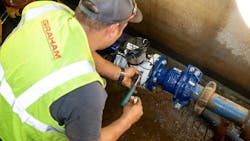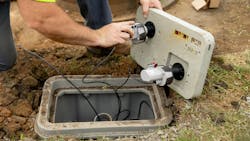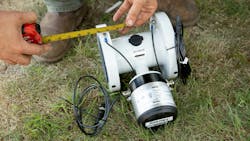Sandy, Oregon, reduces water loss and saves money with a suite of new technology
The city of Sandy, Oregon, has about 4,200 service connections and a staff of about 10 people, only two of which are boots-on-the-ground water technicians. Roughly half of the city’s water comes from local sources, but with not enough capacity at the treatment plant to meet supply, the city also purchases water. To keep costs low the city takes water loss very seriously.
Advanced metering
Joe Johanesen, water supervisor for the city knows that you cannot manage what you cannot measure. To address this, the city upgraded to Mueller Solid State Registers (SSR) with a complete AMI network with five collectors and six repeaters.
“Prior to installing the AMI system, meter reading was a very manual process, and it cost the city $3,000 a month for a meter reader just to read half the service area. The AMI installation has saved the city money, and those savings have gone back into the program to help absorb network and maintenance costs,” Johanesen said.
It has also given the city the ability to get daily, or on-demand, meter reads as opposed to only once a month. And with the contouring topography of Sandy’s service area, utility staff can accurately read meters remotely in hard-to-read areas.
To help keep an eye on complete system usage, the city can also set water use limits for certain connections such as businesses with high water usage and nearby water districts that the city wholesales water to.
In 2024, the city began taking more steps toward modernizing its system, launching a smart city initiative to bring more intelligence to its utility management. Building on the success of its AMI program, the city started a new project to quantify water loss, identify and repair leaks, and optimize pressure management. This systematic approach would allow the city to target critical water loss areas and quantify the results and savings.
Phase 1: Data collection
By isolating one of its pressure zones, the city used a combination of the insertion meters in the new Singer PRVs and the i2O pressure loggers to determine the volume of water going into the zone, less the consumption measured from the AMI meters, and found approximately 33% water loss in this pressure zone. By adding the EchoShore-DX fixed leak monitoring technology, the city was able to locate a leak of 7 gallons per minute, amounting to an average water loss of 15%, in that district metered area (DMA). The technology incorporates the use of acoustic monitors, which are installed in fire hydrant caps throughout the system. The sensors then record data, listening for sounds of potential leaks. That data is then uploaded to the Sentryx Water Intelligence platform, a cloud-based program where it can be analyzed by utility staff to identify points of interest. The sensors can identify even faint acoustical noises emitted by leaks before they become detectable by conventional methods.
Phase 2: Leak detection & repair
With this baseline established Echologics installed more sensors to identify water loss across the neighborhood.
“The sensor nodes are super simple to install and deploy. The technology identifies the exact leak location making excavation and repair much easier and less costly,” Johanesen said.
The quick repair of the 7.85 gallon per minute leak saved over 4,000,000 gallons of water annually from seeping into the ground, amounting to roughly $33,000 saved annually in unbilled water.
EchoShore-DX also has a history tracker component which uses an algorithm to automatically check for a correlation of leaks at specific locations that have a leak history.
“Whether it’s a hole in a copper or a poly line, or a crack in a water main that might not be surfacing, that’s really what we’re looking for—the unknowns, such as a bell joint leaking a little bit off a water main,” said Johanesen.
Phase 3: Pressure management
In addition to leak monitoring, the city identified a critical pressure monitoring zone — Zone 4 — and installed five i2O pressure loggers to help track pressure reduction efforts at various elevations throughout the DMA. i2O’s dedicated patent-protected pilot valve and system control algorithms are designed to optimize network pressure without triggering burst-causing transients to the network.
The city also installed two pressure control valves with built-in insertion meters from Singer. The 6-inch and 10-inch S106-PG Single Rolling Diaphragm Valves feed the pressure zone from two entries. They work together to control the pressure and offer the redundancy of being able to adjust the pressure levels from both sites—it can also be adjusted remotely.
“Having the EchoShore out there to listen and having the pressure control to lower the pressure in the zone is very beneficial,” Johanesen added. “You can still have enough pressure overnight and relieve the pressure in the system, lessening the burden on the pipes. Or, during those low demand periods, even if there are active leaks, you can still keep the pressure low to lessen the loss.”
i2O pressure loggers and advanced pilot valves reduced water loss by another 11 gallons per minute. Johanesen estimates that water loss has reduced from about 22% down to about 18-19% just from the one DMA being addressed.
Managing what is measured
The city may have about 20 alerts from meters in a day. Johanesen explains that with the new data from the loggers and leak monitoring, half of them is usually eliminated immediately because staff already know the reason for the alert, or now have an understanding of the flow in those areas that may cause an alert. He added that it usually comes down to just a few alerts that may need a truck dispatched to investigate.
The city now has one staff member who is tasked with reviewing alerts for points of interest, whether they’re for leaks, tampers, no flows, etc. Some of them might be repeat alerts that the staff has already investigated, but some of them, such as new no flow alerts, have led to the discovery of potential issues.
“For our small team, being able to use the technology to troubleshoot a lot of this stuff saves us time driving around and going into people’s yards and just hit the ones we need to,” said Johanesen. “I think we proved it to ourselves and our director that these are legitimate and good, working products. Our department can now start including more technology into the budget so we can roll out another pressure zone.”
The Sandy is a small city, it has shown big results, proving that with the right blend of technology, a small team can save water and keep water costs down for ratepayers. The city has reduced water loss and system pressure, which has also reduced electrical pumping costs and wear and tear on pipes and other distribution infrastructure.
About the Author
Malay Patel
Malay Patel is senior manager, capital projects for Mueller water products.


